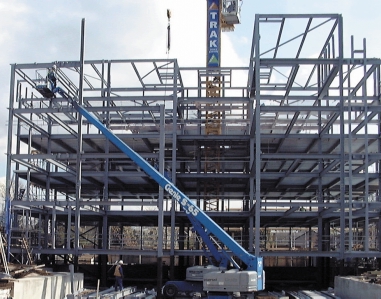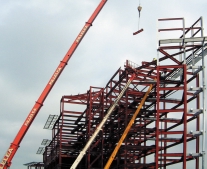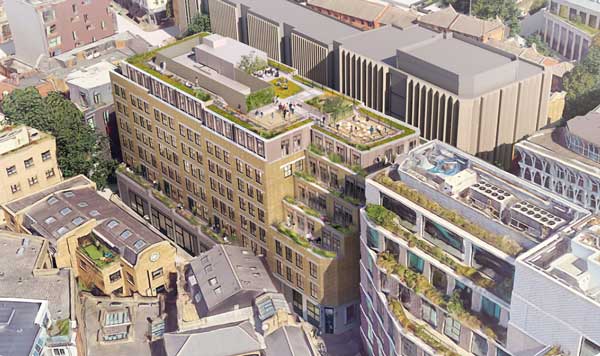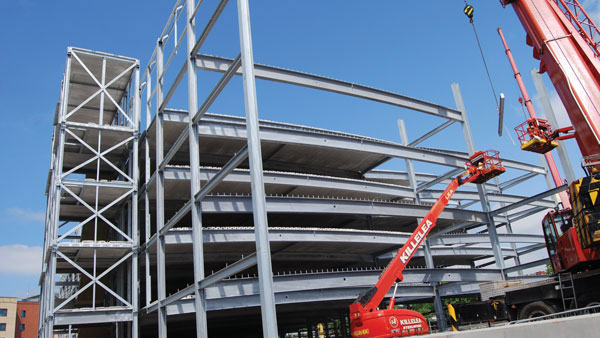Projects and Features
Rising to the residential challenge
How steel technologies are meeting new demand for homes in multi-storey residential buildings
Steel construction has achieved a high market share in many sectors, and the same technology may be used for multi-storey residential buildings, especially in the urban environment. Client benefits may be realised through speed of construction, improved quality and flexibility and adaptability of space provision.
Vauxhall Bridge
 Bourne Steel Ltd has recently completed phase one of a £1.4m contract with Wates Construction for the supply and erection of structural steelwork incorporating fabricated asymmetric beams supporting pre-cast concrete floor planks for an eight storey 101 unit residential block in Vauxhall Bridge Road, London.
Bourne Steel Ltd has recently completed phase one of a £1.4m contract with Wates Construction for the supply and erection of structural steelwork incorporating fabricated asymmetric beams supporting pre-cast concrete floor planks for an eight storey 101 unit residential block in Vauxhall Bridge Road, London.Latinquarter E16
 Latinquarter E16 constructed by main contractors Trak Residential Ltd, in Hermit Road, London, is a new development of 34 contemporary one and two bedroom apartments. The four floors of structural steelwork and metal decking were supplied and erected by H. Young Structures Ltd. Norfolk. The beam and column frame, totalling 260 tonnes, was designed by John Allen Consulting, Sevenoaks, utilising composite metal floor decking. Access was restricted to the footprint of the building, necessitating controlled deliveries to suit the limited storage space. Architectural details were prepared by Alexander Sedgley Ltd.
Latinquarter E16 constructed by main contractors Trak Residential Ltd, in Hermit Road, London, is a new development of 34 contemporary one and two bedroom apartments. The four floors of structural steelwork and metal decking were supplied and erected by H. Young Structures Ltd. Norfolk. The beam and column frame, totalling 260 tonnes, was designed by John Allen Consulting, Sevenoaks, utilising composite metal floor decking. Access was restricted to the footprint of the building, necessitating controlled deliveries to suit the limited storage space. Architectural details were prepared by Alexander Sedgley Ltd.Admiral's Quay
 Admiral’s Quay, Ocean Village, Southampton. Part of a major prestigious residential development on the Canute’s Pavilion site in Southampton which will ultimately provide 435 apartments with parking. Each apartment within the sixstorey development has a balcony. The contract involved the fabrication and erection of the structural steelwork by Bone Steel Ltd using beam and column construction with feature steelwork to each of the balconies..
Admiral’s Quay, Ocean Village, Southampton. Part of a major prestigious residential development on the Canute’s Pavilion site in Southampton which will ultimately provide 435 apartments with parking. Each apartment within the sixstorey development has a balcony. The contract involved the fabrication and erection of the structural steelwork by Bone Steel Ltd using beam and column construction with feature steelwork to each of the balconies..City Point
 City Point, Manchester. James Killelea & Co. Ltd. supplied and erected over 1,100 tonnes of structural steelwork to Costain Ltd for the City Point Phase 2 development in Manchester city centre, an eight storey, 32m high, executive apartment block.
City Point, Manchester. James Killelea & Co. Ltd. supplied and erected over 1,100 tonnes of structural steelwork to Costain Ltd for the City Point Phase 2 development in Manchester city centre, an eight storey, 32m high, executive apartment block.The residential building sector demands more efficient, adaptable and higher quality buildings. The government has called for more building in inner city locations and on brownfield sites to meet the target of four million new homes in 15 years. This will require a new way of building to higher density without impacting on already congested inner cities. Steel construction is well placed to meet this demand, especially in the urban environment, where the benefits of speed of construction can be realised.
The Egan Report Rethinking Construction called for a re-examination of all aspects of construction to improve quality, to encourage innovation, and to maximise pre-fabrication. The financial benefits are:
SPEED OF CONSTRUCTION
All steel construction uses prefabricated components which are rapidly installed on site. In all multi-storey buildings, construction periods can be reduced by at least 20 per cent, in comparison to concrete construction, leading to:
- savings in site preliminaries,
- earlier return on investment,
- reduced interest charges.
These time-related savings can easily amount to two to three per cent of the overall project value. Importantly, in major residential building projects, the pre-sale of show apartments reduces the developer’s working capital and cash flow.
REDUCED DISRUPTION TO THE LOCALITY
In inner city locations it is important to reduce the disruption to the nearby buildings and roads by:
- timing deliveries to site to suit traffic conditions,
- reducing materials use and waste creation,
- minimising noise and dust,
- reducing the construction period.
Steel construction dramatically reduces the impact of the construction operation on the locality.
FLEXIBILITY AND ADAPTABILITY
Steel construction provides long spans in which the space can be arranged to suit different layouts of apartments. Slimflor® and Slimdek® construction provide a flat soffit with complete flexibility of layout. All internal walls can be relocated, leading to fully adaptable buildings.
IMPROVED QUALITY
Off-site prefabrication improves quality by factory controlled production and is less dependent on site trades and the weather. Also, steel does not suffer from creep or shrinkage and does not rot or decay, unlike its competitor materials. Call-backs due to cracking are eliminated. Modular construction achieves much greater levels of quality where all the fit-out is done in the factory.
ENVIRONMENTAL BENEFITS
All steel construction is produced efficiently, in which waste is minimised and recycled. Steel is potentially re-usable and up to 40 per cent of steel production is from scrap. The faster construction process also reduces environmental impact.
COMPOSITE CONSTRUCTION
Composite construction uses hot-rolled steel beams acting compositely with a composite slab. Headed studs may be welded through the steel decking as an on-site process. For smaller projects, Hilti shear connectors may be used where site power is not available.
In composite construction, the weight of the steel beams is reduced by over 30 per cent, and the stiffness is improved so that beams with a span:depth ratio of up to 25 can be designed.
STEEL BEAMS AND PRECAST CONCRETE SLABS
Steel beams may also be combined with precast concrete hollowcore slabs in two forms:
- downstand beams support precast units on the top flange, in which the recommended minimum flange width is 190 mm;
- Slimflor beams, support the precast units on an extended plate welded to the bottom flange of a UC section.
Downstand beams are usually aligned with separating walls but, even so, the wider beam may project outside of the wall line. In Slimflor construction, a flat soffit is created in which walls may be installed anywhere on plan.
THE BENEFITS OF STEEL IN HOMES
Sustainable construction
- energy efficiency,
- efficient materials use,
- minimises waste,
- ability to be recycled or re-used,
- future adaptability,
- long life product.
Rethinking Construction
- reduced costs,
- reduced time on site,
- increased productivity,
- certainty of budget & time,
- reduced wastage,
- safer construction,
- higher quality.
Dr. Derek Tordoff, Director General of the British Constructional Steelwork Association













